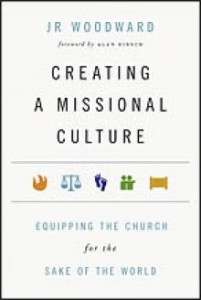Creating a Missional Culture: Equipping the Church for the Sake of the World
J. R. Woodward, IVP, Downers Grove, IL 60515-1426, 2012, 256 pages, $25.00.
As the volume of missional church literature increases, North America is recovering the apostolic impulse of the church. Yet, as the books on mission are shelved the challenge of planting, leading and growing truly missional churches remains. What is required to create missional church culture? How do we evaluate the church’s maturity as it grows? How do we create missional leaders that stay the course? In four parts, Woodward creatively addresses all of these questions.
Polycentric Leadership

Part one lays a conceptual foundation, focusing on the meaning of culture and the necessity of leaders to become “cultural architects.†The task of the culturalarchitect is not only to teach Scripture and shepherd God’s people, but to lead the way in developing environments where people will learn God’s truth, be healed by God’s power, be welcomed by his love, be liberated by his grace, and thrive as part of a mature missional community under the headship of Christ. Woodward provides helpful diagnostic questions to evaluate these five environments in the local church. These environments may seem arbitrary, but in parts two and three, Woodward introduces a model of leadership from Ephesians four that corresponds with these environments—polycentric leadership. Grounding polycentric leadership in the social Trinity and a Christ-centered reading of Ephesians, Woodward calls for “a polycentric structure, where leaders interrelate and incarnate the various purposes of Christ…†(60). The apostle, prophet, evangelist, pastor, and teacher are essential to cultivating the five environments in order to equip the church for the work of mission to the world. How do they do it? According to Woodward, each of the five leaders use “thick practices†to cultivate their environments for mission.
The 5 Equippers: Apostle, Prophet, Evangelist, Pastor, & TeacherÂ
The apostle makes disciples and reflects through Sabbath for the church to thrive and rest in God’s mission. The prophet calls disciples to liberation from sin through the healing experience of spiritual disciplines. The evangelist helps the community become welcoming to the lost through hospitality and sharing God’s story with others. The pastor fosters a healing community through the practices of confession and peacemaking, promoting a reconciled community. The teacher cultivates an ethos of learning by encouraging people to participate in sacred assemblies for equipping and future-oriented living. The church is to be a foretaste of the future, where peace and righteousness dwell. Polycentric leaders work together to cultivate the whole church in diverse ways for the mission of God. In the closing chapters, Woodward provides some examples of this collaborative leadership in shared preaching and communal decision-making. He warns that the polycentric approach is messy but affords the church an opportunity to be influenced by its various equipping gifts and voices.
Conclusion
Woodward is well read across the theological disciplines. He has thought creatively and practically about how to lead and multiply missional churches. His creativity is both a strength and a weakness. Those unwilling to absorb his new language for equipping the church will miss out on a rich application of biblical leadership. After all “our approach to leadership makes a theological statement to the church and the world.†(96). Once absorbed, a shift to polycentric leadership leaves the reader wanting more practical bite. More concrete examples of this type of leadership and equipping would have been helpful. Perhaps Woodward will offer these in a later volume. Some will desire more exegetical support for this leadership, which can be found in Hirsch and Catchim’s book below. Creating a Missional Culture is a worthwhile read that provides a gracious yet prophetic corrective to individualistic, pastor-centric churches.
This review originally appeared in the excellent missions journal, EMQ.
Check these titles:
Hirsch, Alan and Tim Catchim, 2012. The Permanent Revolution: Apostolic Imagination and Practice for the 21st Century. San Francisco, CA.: Josey Bass.
Breen, Mike, 2012. Multiplying Missional Leaders. 3DM Press.
